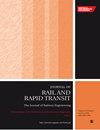Feature analysis of precipitation-induced subgrade defects on a high-speed rail ballasted track using multiple track inspection data: A case study
IF 1.7
4区 工程技术
Q3 ENGINEERING, CIVIL
Proceedings of the Institution of Mechanical Engineers Part F-Journal of Rail and Rapid Transit
Pub Date : 2024-02-16
DOI:10.1177/09544097241234094
引用次数: 0
Abstract
Heavy rainfall has posed a great challenge to the service performance of high-speed rail (HSR) substructure, resulting in a reduction in the ride quality and safety of high-speed trains. To carry out proper repair work for the substructure, it is imperative to realize efficient identification of precipitation-induced subgrade defects. To this end, this paper aims to extract the features of typical precipitation-induced subgrade defects from the multiple track inspection data to provide a basis for defect identification. Firstly, the geotechnical site investigation including Ground Penetrating Radar (GPR) detection, moisture content test, and dynamic cone penetration (DCP) test of a typical defective spot is performed to determine the condition of the subgrade after heavy rainfall; then, the analysis methods of track inspection data are introduced; finally, the track geometry data and carbody acceleration data of four typical defective sections are analyzed, and the time-domain, frequency-domain and discrete wavelet transform (DWT)-based features which are highly correlated with the precipitation-induced subgrade defects are extracted. The results show that the feature indexes extracted from track surface irregularity and carbody vertical acceleration increase significantly after heavy rainfall; the long wavelength components (8 m and above) of both track irregularity and carbody vibration are more sensitive to the subgrade defects, which is reflected by the sharp increase of the DWT-based features at some levels corresponding to long wavelength ranges. The results of defect feature extraction based on the track inspection data agree well with the geotechnical site investigation results, which demonstrate the feasibility of utilizing multiple track inspection data to identify the typical precipitation-induced subgrade defects.利用多重轨道检测数据对高速铁路有砟轨道上由降水引起的路基缺陷进行特征分析:案例研究
暴雨给高速铁路(HSR)下部结构的服务性能带来了巨大挑战,导致高速列车的行驶质量和安全性下降。为了对下部结构进行适当的维修工作,必须实现对降水引起的路基缺陷的有效识别。为此,本文旨在从多次轨道检测数据中提取典型降水诱发路基缺陷的特征,为缺陷识别提供依据。首先,对典型缺陷点进行岩土现场勘察,包括探地雷达(GPR)探测、含水量测试和动态锥入度(DCP)测试,以确定暴雨后的路基状况;然后,介绍轨道检测数据的分析方法;最后,分析了四个典型缺陷区段的轨道几何数据和车体加速度数据,提取了与降水引起的路基缺陷高度相关的基于时域、频域和离散小波变换(DWT)的特征。结果表明,从轨道表面不平顺性和车体垂直加速度中提取的特征指数在强降雨后明显增加;轨道不平顺性和车体振动的长波长分量(8 米及以上)对路基缺陷更为敏感,这反映在基于 DWT 的特征在长波长范围对应的某些级别上急剧增加。基于轨道检测数据的缺陷特征提取结果与岩土工程现场勘测结果吻合,这证明了利用多个轨道检测数据识别典型降水引起的路基缺陷的可行性。
本文章由计算机程序翻译,如有差异,请以英文原文为准。
求助全文
约1分钟内获得全文
求助全文
来源期刊

CiteScore
4.80
自引率
10.00%
发文量
91
审稿时长
7 months
期刊介绍:
The Journal of Rail and Rapid Transit is devoted to engineering in its widest interpretation applicable to rail and rapid transit. The Journal aims to promote sharing of technical knowledge, ideas and experience between engineers and researchers working in the railway field.
 求助内容:
求助内容: 应助结果提醒方式:
应助结果提醒方式:


